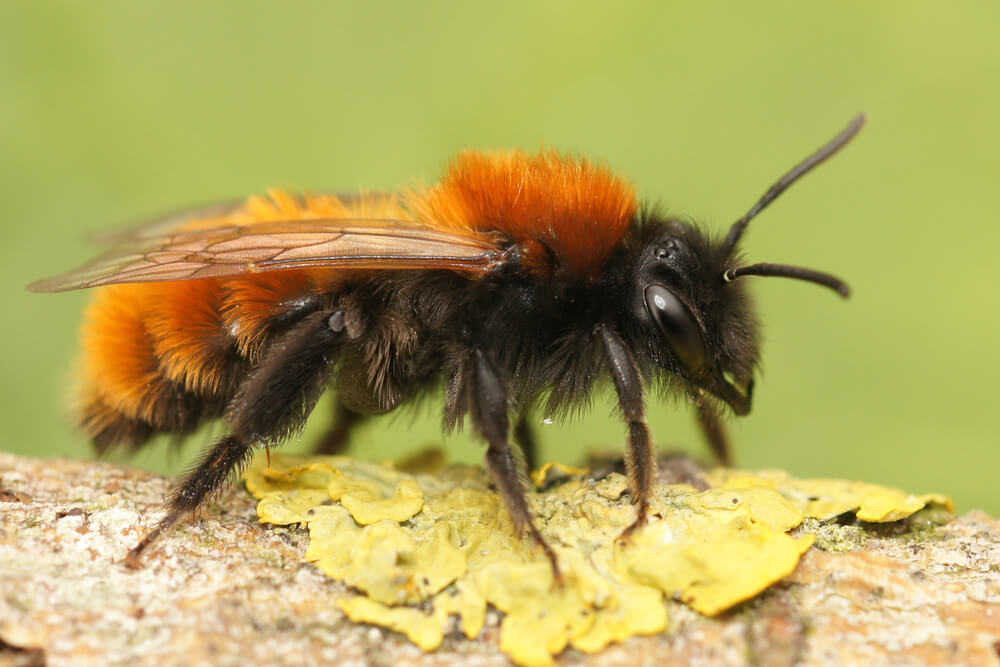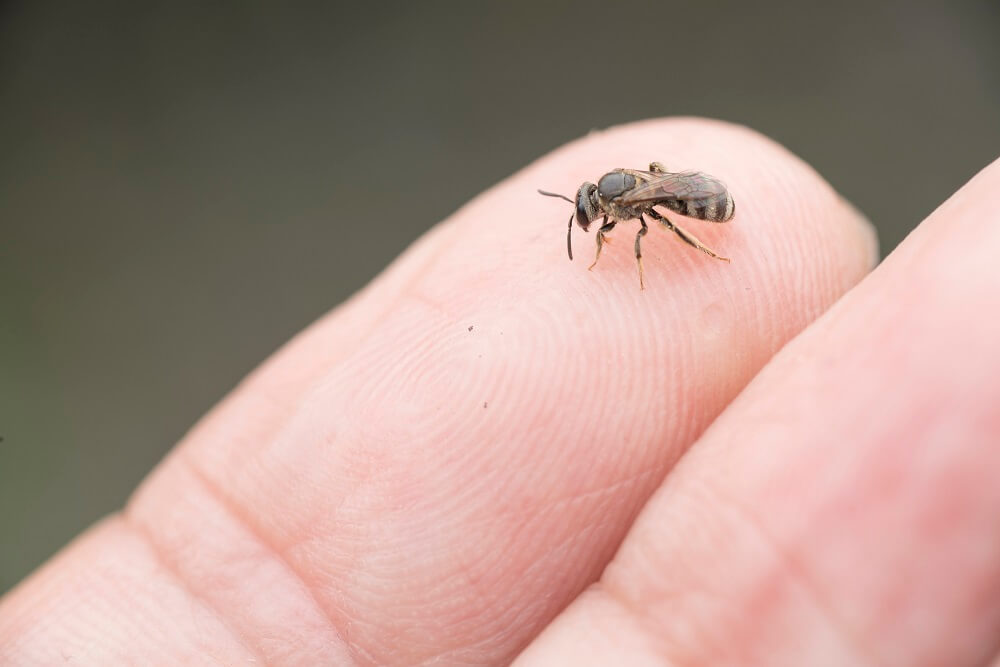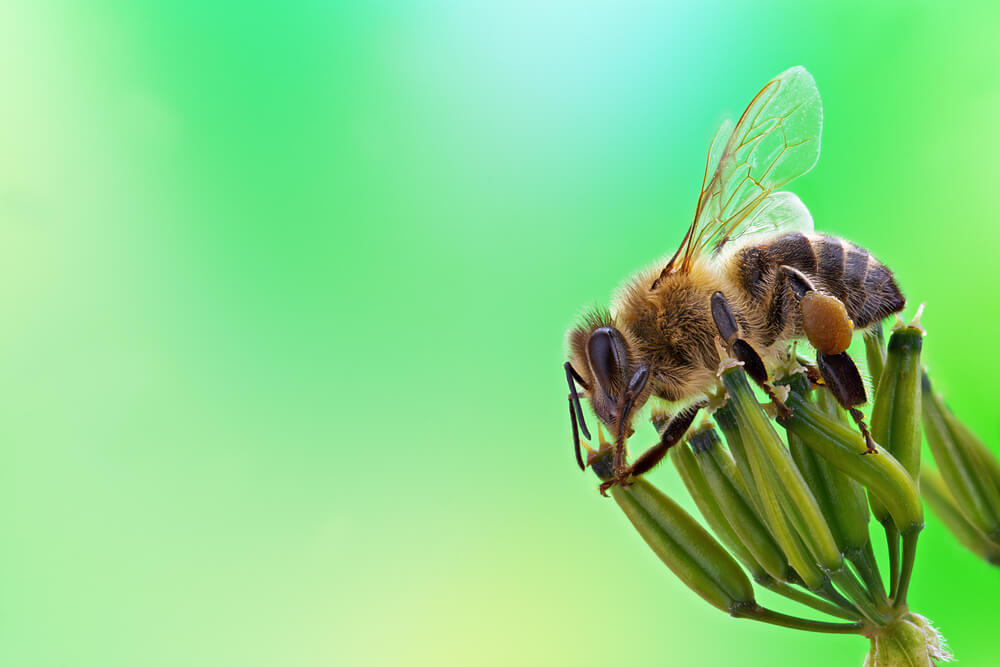Table of Contents:
What Does a Bee’s Antennae Do?
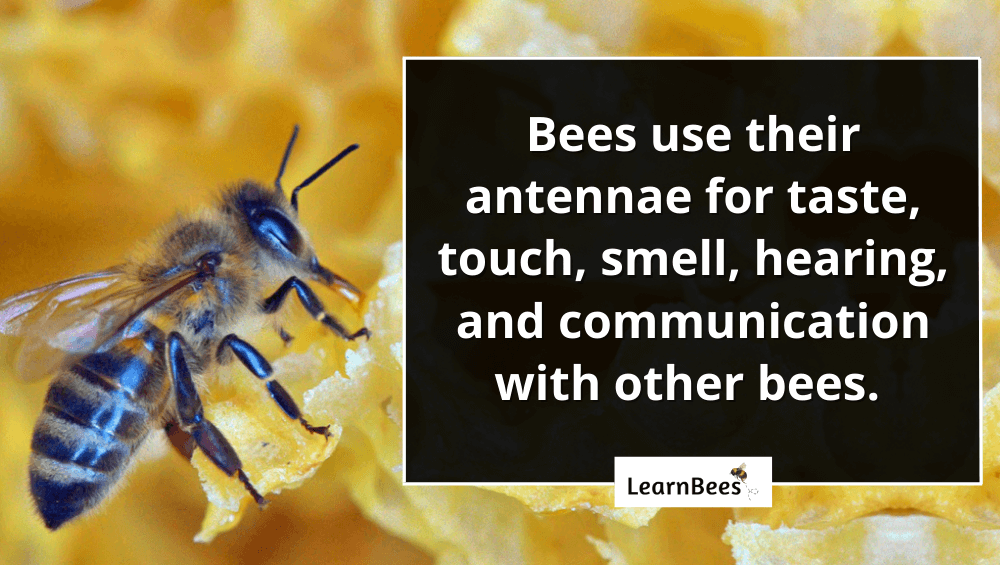
Bees use their antennae for many things, including:
- Taste – Antennae are covered in sensilla, which are little hairs that act like ‘taste buds.’ Bees can have hundreds of these taste-sensing hairs on their antennae.
- Sound – Despite not having ears, bees can detect sound waves using antennae. They have a special sensor at the base of their antennae that allows them to detect vibrations.
- Scent – The tiny hairs that cover the antenna (called sensilla) also have odor receptors that allow the bee to smell the world.
- Temperature – Antennae can detect temperature, carbon dioxide, humidity, and wind speed.
So how does this translate into a bee’s daily life?
A few ways.
For starters, a bee’s diet consists of pollen and nectar from flowers. Bees use their antennae to detect flowers to forage on.
You see, a bee’s primary goal is to find flowers with the highest nectar content. But visiting every flower to taste its nectar content would be too time-consuming.
So this is where a bee’s antennae come in.
They can use them to sniff out the best sources of nectar, without having to test every single flower.
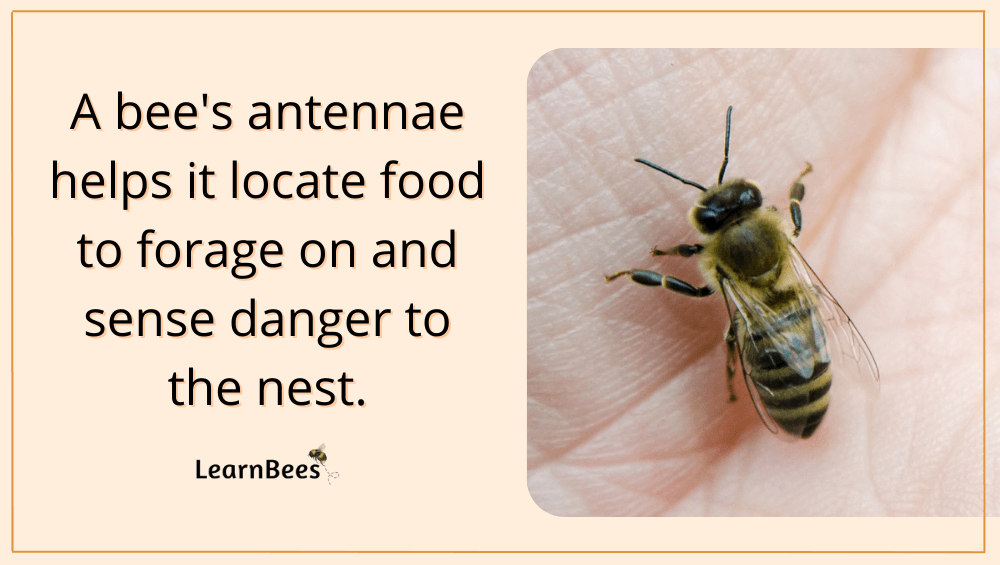
Secondly, bees use their antennae to communicate with each other.
For example, when bees give food to their colony members, they use their antennae to signal readiness to begin the food transfer.
More importantly:
Bees use their antennae during mating. When the queen bee is ready to mate, she releases a pheromone that attracts male bees. As such, the male bees use their antennae to detect this pheromone.
And to take it a step further?
Queen bees also release alarm pheromones that signal to the colony that there is danger nearby.
This could be a danger due to a potential predator or danger due to a fire or natural disaster. Either way, the other hive members use their antennae to detect these alarm pheromones.
How Many Antennae Does a Bee Have?
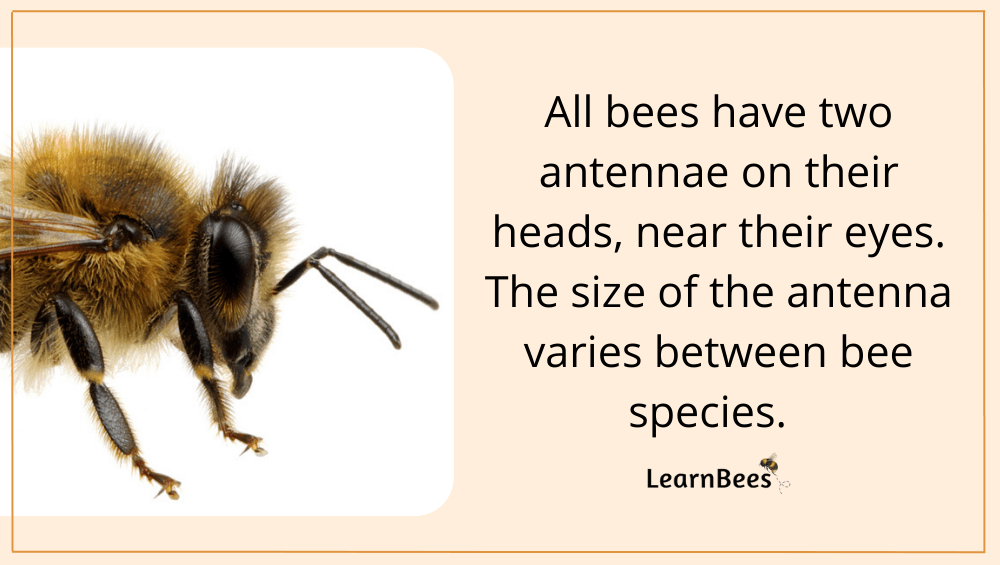
Bee’s have two antennae.
A honeybee’s antennae are made of 3 primary parts. These include:
- The scape which is the segment that attaches to the bee’s head.
- The pedicel which attaches to the scape to form an elbow-like joint that allows the antennae to rotate easily
- The flagellum which includes receptors
But here’s the interesting part:
Not all insects have antennae that are bent like honeybees. For example, certain moths have long, straight antennae. Their antennae doesn’t have elbow-like joints in them like bees do.
But like bees, other insects use their antennae to touch, taste, and smell the world around them.
So now you might be asking:
Do all bees have antennae?
Yes, all bees have antennae. Antennae are crucial for a bee’s survival. Without them, they wouldn’t be able to perform daily functions related to hearing, tasting, and smelling.
Bees need their antennae the same way they need their wings. If a bee damages a wing or antenna, its lifespan is considerably shortened.
Why Do Bees Rub Their Antennae?
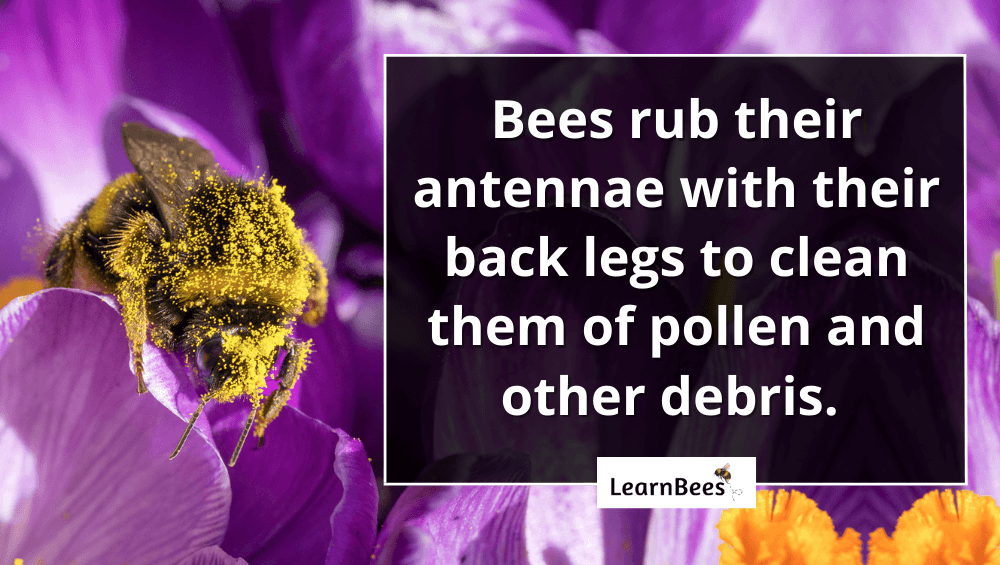
Bees rub their antennae to clean them.
In fact, bees clean their antennae constantly. The antennae have to be kept immaculately clean because they’re so essential to the bee’s ability to taste, smell, hear, and so on.
And want to hear something interesting?
Bees even have special antenna cleaners on their forelegs.
This antennae cleaner is called a ‘strigilis.’ Think of the strigilis like a comb that humans use. It’s made up of stiff hair that the bee runs its antenna through to clean it.
Why is this important?
Because bees collect debris such as pollen or dust on their antennae. Such debris needs to be cleaned, so it doesn’t interfere with the many sensors of the antenna.
With that said:
Cleaning techniques vary amongst bee species.
Keep in mind that there are more than 20,000 different species of bees. Common examples include carpenter bees, honeybees, and bumblebees.
Some bees are called ‘uniscrapers,’ which means they clean their antennae with one stroke.
Other bees are called ‘biscrapers,’ which means they clean their antennae using two to three strokes, one after the other.
FAQs on Bee Antennae
- What type of antenna do honeybees have?
- How many antennae does a bee have?
- Where is the antennae on a bee?
- How many antennae do honey bees have?
- What does a bee’s antennae do?
- Why do bees rub their antennae?
- Do bumblebees have antennae?
- Do bees have long antennae?
- Does a bee have feelers?
- Why do bees need their antennae?
- Do all bees have antennae?
- How long are a bee’s antennae?
What type of antenna do honeybees have?
Honeybees have geniculate antennae. Geniculate antennae have elbow-like parts that bend, allowing them to move their antenna easily. Sort of how humans have knees and elbows that allow us to move our legs and arms.
Bumblebees also have geniculate antennae, along with many other bee species.
But not all bees have geniculate antennae. For instance, some solitary species have filiform antennae.
Solitary bees are bees that live alone, such as mason bees or carpenter bees. Social bees live in colonies, such as honeybees or bumblebees. These colonies are family units where every bee pulls its weight to ensure the future generation of the colony.
Filiform antennae comprise of many short, straight segments rather than long ones. They’re very common in other insects, such as grasshoppers.
—> Go back to the FAQs on bee antennae
More to Explore:
How many antennae does a bee have?
Bees have two antennae.
Each antenna has multiple segments connected by joints, allowing the bee to move its antenna in different directions. The number of segments varies based on the bee species.
The antenna is located on the head of the bee.
For example, the honeybee head appears triangular when seen from the front. The two antennae sit close together near the center of the honeybee’s face. The bee also has two compound (large) eyes and three simple (small) eyes on its head.
These two antennae may appear small and unimportant, but they’re actually crucial data collecting tools for bees. Bees use them for touch, taste, smell, and communication. Without them, a bee’s life would be considerably shortened.
—> Go back to the FAQs on bee antennae
More to Explore:
Where is the antennae on a bee?
Bees actually have two antennae that are located on their head.
The antennae are generally close to the center of the bee’s face and near its eyes. If you look at a close-up picture of a bee, you’ll see the two antennae sticking out from the head.
This is true for all species of bees.
Remember:
There are over 20,000 different kinds of bees, including bumblebees, mason bees, and honeybees. Each type has two antennae that they use for their survival.
When the bee is out foraging for pollen and nectar, their antennae often get covered in debris such as dust or pollen. As a result, the bee uses its forelegs to clean its antennae. Cleaning is crucial because it helps the bee avoid interference with its many sensory organs.
Dirt and debris could interfere with the bee’s ability to taste, touch, smell, or hear.
—> Go back to the FAQs on bee antennae
More to Explore:
How many antennae do honeybees have?
Honeybees have two antennae, just like all other bee species.
The antennae are located on the honeybee’s head and are used for touch, taste, smell, hear, and communicate.
—> Go back to the FAQs on bee antennae
More to Explore:
- Do Carpenter Bees Pollinate?
- How Long Do Bumble Bees Live?
- Honeybees vs. Bumblebees: How Do They Compare?
What does a bee’s antennae do?
A bee’s antennae are necessary for the bee’s daily life, including:
- Taste: The antennae have tiny hairs called sensilla that the bee uses to taste the pollen and nectar it collects. Bees can have hundreds of different types of sensilla.
- Sound: Despite not having ears, bees can detect sound waves using their antennae. They have a unique sensor at the base of their antennae that allows them to pick up vibrations.
- Scent: The bee’s tiny hairs (known as sensilla) cover its antenna and contain odor receptors that help the insect smell the environment.
- Temperature: Antennae can also detect temperature, humidity, carbon dioxide, and even wind speed.
So how do bees use antennae in their everyday life?
Several ways.
A bee’s diet consists mainly of pollen and nectar from flowers. The bees must use their antennae to detect the nectar of flowers to find the best ones to forage on.
Bees prioritize the flowers with the greatest nectar content because they rely on nectar as their carbohydrate source. But it’s time-consuming to go through each blossom and taste its nectar content.
So this is where a bee’s antennae come to the rescue. They’re able to utilize them to smell out the best nectar sources.
Secondly, bees utilize their antennae for communication.
When bees give food to their colony members, they use their antennae to indicate that the food transfer is ready to begin.
And just as important:
Bees utilize their antennae during mating. When the queen bee is ready to mate, she releases a pheromone that attracts males bees. The male bees can detect this pheromone using their antennae.
And to take it a step further?
Queen bees also produce alarm pheromones, which alert the colony to threats.
Potential threats could be predators like bears, skunks, or honeybadgers. It could also be a natural disaster like a fire. Either way, the other colony members utilize their antennae to detect these alarm pheromones.
—> Go back to the FAQs on bee antennae
More to Explore:
Why do bees rub their antennae?
Bees use their forelegs to clean their antennae. This is crucial because it helps the bee avoid interference with its many sensory organs. Dirt and debris could interfere with the bee’s ability to taste, touch, smell, or hear.
—> Go back to the FAQs on bee antennae
More to Explore:
Do bumblebees have antennae?
People often ask, “How many antennae do bumblebees have?”
All bees have two antennae, including bumblebees.
There are more than 250 bumblebees species. They fall in the genus Bombus and are part of the Apidae family. The antennae are located on the bumblebee’s head and are used for touch, taste, smell, hear, and communicate.
—> Go back to the FAQs on bee antennae
More to Explore:
Do bees have long antennae?
Yes, bees have two long antennae on top of their head.
There are even a species of bees called longhorn bees, named after their long antennae. That said, female long-horned bees have shorter antennae than males do. There are about 120 species of longhorn bees in North America.
—> Go back to the FAQs on bee antennae
More to Explore:
- Ground Bees: Are They a Threat to Your Yard?
- Wasps vs. Honeybees: Are They Different?
- Do Bumble Bees Bite?
Does a bee have feelers?
Yes, when people refer to a bee’s “feelers,” they’re referring to its antennae.
Bees have two feelers (antennae) on their head for touch, taste, smell, and communication.
Additionally, other insects have antennae as well. Antennae are segmented appendages that protrude from an insect’s head. They vary in length and shape depending on the species of insect.
Antennae are sensory organs insects use to detect and navigate their surroundings. They’re exceptionally complex organs that resemble a combination of human fingertips, noses, and tongues, allowing insects to comprehend a lot about their surroundings.
—> Go back to the FAQs on bee antennae
More to Explore:
- What Does a Bee Sting Look like?
- Do Bees Die When They Sting?
- The Best Essential Oils for Bee Stings
Why do bees need their antennae?
Bees need their antennae for survival. They use their antennae for many things, including smell, taste, touch, and communication.
Bees use their antennae to find food sources, like flowers with nectar. They also use them to communicate with other bees in their colony.
Bees even use their antennae during mating. The queen bee releases a pheromone that attracts male bees. The male bees can detect this pheromone using their antennae.
So, as you can see, bees rely on their antennae for many things.
—> Go back to the FAQs on bee antennae
More to Explore:
Do all bees have antennae?
Yes, all bees have antennae. There are more than 20,000 bee species, and they all have two antennae. The antennae are located on the bee’s head and are used for communication, touch, taste, smell, and hearing.
Honeybees, for example, use their antennae to communicate the location of food sources to other bees in their colony.
Bees also use their antennae during mating. The queen bee exudes a scent that entices male bees. The males can smell this substance using their antennae.
So as you can see, bees are pretty dependent on their antennae.
—> Go back to the FAQs on bee antennae
More to Explore:
How long are a bee’s antennae?
The length of a bee’s antennae depends on the species of bee. For example, longhorn bees are known for their long antennae.
But, most bees generally don’t have as long antennae as longhorn bees do. For example, you’ll notice that bumblebees and honeybees have shorter antennae.
